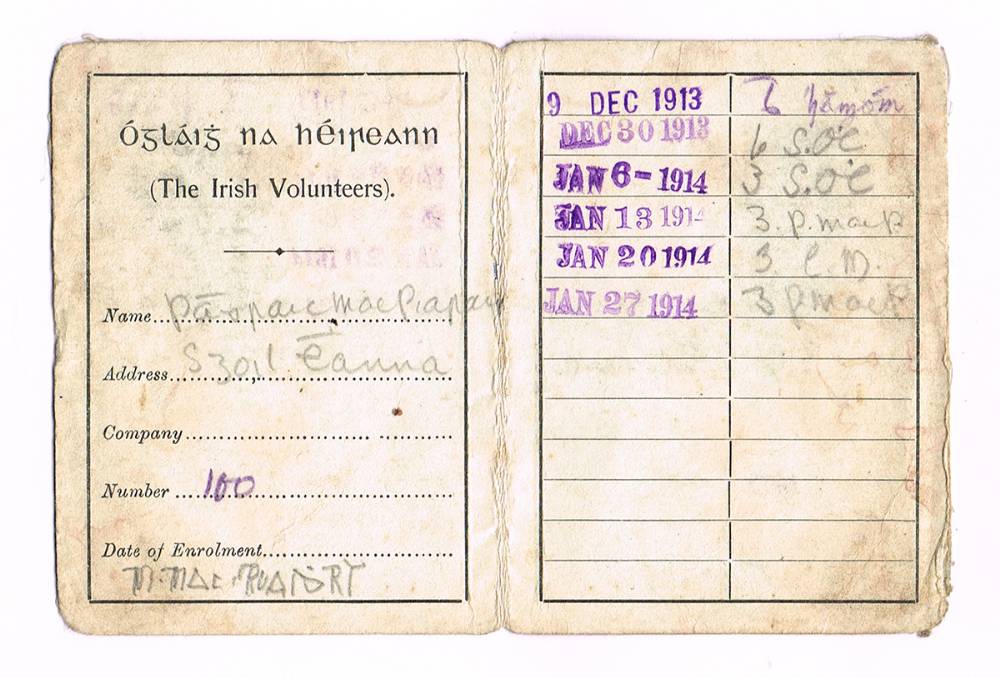
Padraig Pearse’s 1913 membership card for The Irish Volunteers is the top lot at Whyte’s History sale on November 11. The rarity of this treasure is reflected in an estimate of €150,000-250,000. It is inscribed in Pearse’s own hand in indelible pencil: Pádraic Mac Piarais Sgoil Éanna and numbered 100. The card was gifted by Pearse’s mother Margaret to Micheál Mac Ruaidhrí, thence to his daughter Brid who gifted it to the family of the present owner.
Micheál Mac Ruaidhrí was a mentor and confidant to Padraig Pearse. Dubbed ‘the greatest seanchaí of our time’ by the scholar and patriot Eoin MacNeill, and known to Professor Douglas Hyde, Ireland’s first President, as ‘The Mayo Poet’ because of the musical quality of his Irish he was born in Mayo in 1860. Mac Ruaidhri suffered from poor eyesight and as a result spent just two days in school, preferring instead to occupy his days with the elders of his area. In the process he amassed and retained a vast knowledge of folklore, sagas, history, song and music, all of which he dearly loved, whilst also gaining a genuine love for and understanding of the soil.
As a young man Micheál went to Dublin and worked as a gardener at Stradbrook Estate, Blackrock, before striking up a relationship with the revolutionary and educationalist Patrick Pearse. From the foundation in 1908 of Pearse’s Cullenswood School in Ranelagh, Dublin, Micheaál taught practical gardening and horticulture and in 1910, he, together with his bride, the former Alice Wallace, relocated with Pearse to the Hermitage in Rathfarnham, the site of the future and much celebrated Scoil Eanna -‘St. Endas.’ The Hermitage was to be the site of a new school for boys based on the ancient Irish custom of fosterage, while Cullenswood became a girls school which Pearse named Scoil Íde. St. Enda’s influence on the 1916 Rising is evident by the list of those participants who taught at or attended the school. In addition to Mac Ruaidhri and his assistant Patrick Donnelly and the patriot Pearse brothers, Patrick and Willie, other revolutionaries such as Thomas MacDonagh, Eamon Ceannt, Con Colbert and Fergus de Burca also taught there, as did the writers Padraic Colum and Standish O Grady. Desmond Ryan who fought in the GPO and and Joseph Sweeney who was a sniper on the roof of the GPO were among the sixteen St. Enda’s pupils who participated in the 1916 Rising.
Mac Ruaidhri was in the G.P.O. Dublin, with Pearse on Easter Monday 1916, and stood beside Pearse as he read the Proclamation of the Irish Republic. Due to his bad eyesight and the fact that he was 56 years of age at the time, he was ordered back to St. Enda’s by Pearse with instructions to destroy or hide secret documents. Following the suppression of the 1916 Rebellion, Mac Ruaidhrí was arrested and imprisoned in Frongoch Prison, Wales: at the time he was the oldest prisoner in the gaol and spent his days teaching Irish and history to the other rebel inmates. On his release he returned to St. Enda’s and resumed his career as gardener. After the signing of the Anglo-Irish Treaty in 1922, a treaty he disagreed with, MacRuaidhri took no further part in politics and concentrated instead on his writing and folklore collecting. Those who sought out his wisdom and knowledge included Eamon De Valera, Dr.Douglas Hyde and Micheál Ó Tiomaindhe (Michael Timoney 1870-1940). Micheál MacRuaidhrí died in May, 1936 aged 76 at his home, St Enda’s Lodge, was buried in Glasnevin cemetery, Dublin.



